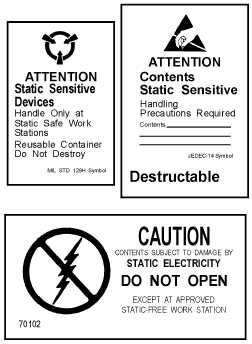2-13
Figure 2-5.—Warning symbols for ESDS devices.
You commonly experience static build-up during the winter months when you walk across a vinyl or
carpeted floor. (Synthetics, especially plastics, are excellent generators of static electricity.) If you then
touch a doorknob or any other conductor, an electrical arc to ground may result, and you may receive a
slight shock. For you to experience such a shock, the electrostatic potential created must be 3,500 to 4,000
volts. Lesser voltages, although present and similarly discharged, normally are not apparent to your
nervous system. Some typical measured static charges caused by various actions are shown in table 2-1.
Table 2-1.—Typical Measured Static Charges (in volts)
RELATIVE HUMIDITY
ITEM
LOW (10 - 20%)
HIGH (65 - 90%)
WALKING ACROSS CARPET
35,000V
1,500V
WALKING OVER VINYL FLOOR
12,000V
250V
WORKER AT BENCH
6,000V
100V
VINYL ENVELOPES FOR WORK INSTRUCT.
7,000V
600V
POLY BAG PICKED UP FROM BENCH
20,000V
1,200V
WORK CHAIR PADDED WITH URETHANE FORM
18,000 V
1,500 V
Q-10.
At approximately what minimum voltage potential should you be able to feel an electrostatic
discharge?
Metal oxide semiconductor (MOS) devices are the most susceptible to damage from ESD. For
example, an MOS field-effect transistor (MOSFET) can be damaged by a static voltage potential of as
little as 35 volts. Commonly used discrete bipolar transistors and diodes (often used in ESD-protective
circuits), although less susceptible to ESD, can be damaged by voltage potentials of less than 3,000
electrostatic volts. Damage does not always result in sudden device failure but sometimes results in
device degradation and early failure. Table 2-1 clearly shows that electrostatic voltages well in excess of


